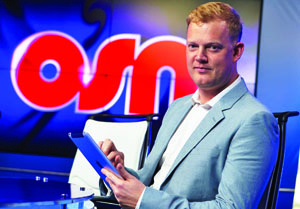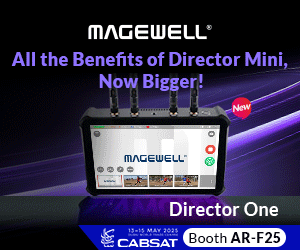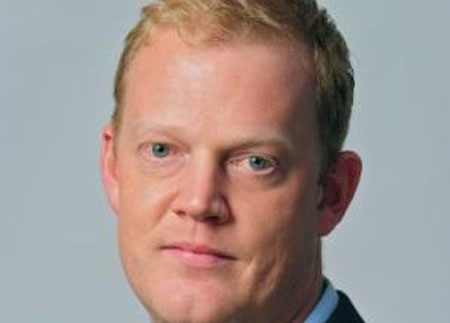David Hanson, Director of Digital at OSN, explains how new media is complementing traditional broadcasting platforms to enrich the viewing experience and what the future has in store How long have you been with OSN? I have been with OSN since 2004. I used to work with the linear channels as Director of its Western […]
David Hanson, Director of Digital at OSN, explains how new media is complementing traditional broadcasting platforms to enrich the viewing experience and what the future has in store
How long have you been with OSN?

I have been with OSN since 2004. I used to work with the linear channels as Director of its Western programming but the digital area has always appealed to me. When the opportunity came, I moved to digital technology. I havent looked back since.
Tell us about the progress of your second/third screen platform since it was launched in March last year.
OSNs digital platform has evolved rapidly since its launch. We concentrate on improving in three key areas.
The first is reach. By targeting and supporting more devices, we increase the number and variety of addressable users and make the service more convenient to current users. Thats why weve invested a lot in releasing to smartphones and supporting 3G streaming.
The second is content. We are constantly looking to improve the service by adding new programmes. In the past two months, weve seen an exclusive preview of House of Cards, exclusive digital programming in Hannibal, The Kennedys and Hemlock Grove, and a hugely successful Ramadan catch-up service.
Finally, were also developing new services. Live streaming was a big success when we launched last year. This year has seen the launch of our pay-per-view service OSN Box-office on OSN Play and were getting ready to release an update to the player with a whole raft of service improvements including bookmarking, which gives you the ability to pause viewing on one device and pick up where you left off on another.
How would you describe the journey?
We are fortunate to have a CEO and a Board of Directors who are very forward thinking. They didnt merely see this as an opportunity but as vital to the growth of our business in the long term. One of the initial challenges that anyone faces in this kind of a scenario is making people understand that you are not threatening their existence. It is more of a complementary relationship. Once that was addressed, the new challenge was to build the skills and knowledge base necessary internally to develop our digital offering and deliver it to the market. It has been a steep learning curve but we have never missed a beat or felt that we needed to lose a step.
What were your initial challenges?
Following the merger, we had just invested a lot of money in closing the platform and all of a sudden, we were going to launch a platform that would make the content available across multiple devices.
We quickly needed to understand the digital rights management (DRM) issues and make sure that the technology was 100% secure.
We had to ensure that the platform we launched was both robust and technically advanced. Most of the team was from the broadcast media so we also had to ensure that we had the right combination of skills and knowledge to launch something that would be a game changer.
How is your digital offering different from other product offerings in the market?
There are two elements to this. On the one hand, our benchmarks are other leading international pay TV companies such as HBO and Sky. These platforms, however, tend to cater only to one base, which is primarily an English-speaking population. Ours, by comparison, is built to support both English and Arabic in terms of navigation, subtitling and providing dual audio tracks. So, while we are more international in terms of the scale and scope of what we are doing, we are very regional in terms of our content offerings. Our content sets us apart. Where else can you find all of the latest Hollywood movies alongside great Arabic drama and comedy, and two 24-hour live streaming sports channels?
We have also tried to stay consistent in terms of the look and feel, and the quality of the experience that people are used to on our traditional platform.
Within the bouquet of OSN services, OSN Play is unique because it is delivered directly to the customers own devices rather than to an OSN box. This is a new experience for OSN as were used to delivering content to our own boxes within a closed platform. Again, this makes the platform more personal than ever before. Because we are streaming expensive and extremely valuable content within 24 hours of it being broadcast on our devices, the technology, the security and the streaming experience has to be spot on.
Has security not been an issue when you made your content available across so many devices?
No. For one, the services are geo-blocked within the region. Secondly, the service is limited to registering two devices to your OSN account. There is a rigorous process on how we authenticate it with that platform. We dont see too much risk involved as most people today are asking us to extend that registration to more devices. Over a period of time, we may allow people to register more devices but may limit the content to two concurrent streams at a time.
What technology are you using to implement this service?
We developed the platform in partnership with Ioko 365, which is a part of Kit Digital. It runs on Microsoft Silverlight using Smooth Streaming and the PlayReady content security system. Microsoft Silverlight is a tool for creating and delivering rich internet applications and media experiences on the web. Smooth Streaming, an IIS Media Services extension, enables adaptive streaming of media to Silverlight and other clients over HTTP. Smooth Streaming provides a high-quality viewing experience that scales massively on content distribution networks, making true HD 1080p media experiences an option. Microsoft PlayReady is a content access and protection technology for digital entertainment services, devices and applications.
Is OSN Play fully integrated with your traditional platform?
It has been integrated into the existing OSN structure wherever possible. A digital team was created to make editorial and content decisions specifically for the platform. Media coordination, IT support and marketing are all managed by the relevant OSN department alongside traditional broadcast functions.
The content is managed on the same Harris Broadcast Master system that powers our linear channels. Our EPG (Electronic Programme Guide) team manages the metadata in a specially designed piece of software known as BOB.
Content is transcoded into one format for delivery over WiFi and internet, and a second HLS format for delivery over 3G/4G networks. Our live streaming channels are picked up off the satellite signal in Europe and digitised by Level 3, which provides our CDN services.
The system is also developed in such a way that it stores the subscribers information. When a subscriber accesses OSN Play, his linear subscription is replicated. So if I have subscribed to movies and I try and watch a sports channel that is not part of my linear package, OSN Play will notify me that I am not subscribed to receive the sports channel. The team was able to develop it in such a way that it would be linked to a subscriber on the basis of his package. Other information also then becomes available including the customers usage, his programming preferences, what devices he uses and which one he uses the most. This data will eventually enable us to tailor our subscription packages. So that is one of those areas where we will be able to serve our customers in the long run much better from what we are doing in the traditional environment.
How big is your digital team?
It started with one; now we are up to about five and next year, I think it will double.
What are your plans with regards to apps?
We want everything we create to feed into every element of the OSN platform. An example is the OSN TV Guide app we launched on iOS devices (iPad and iPhone). It gives you the whole of the EPG, features and highlights and then, when you click on a programme, if you have the OSN+ HD progressive download box, you can remote record straight to the box. These are the kind of applications we are looking at that tie the whole platform together. We launched this about three months ago.
We are now looking to take that further by allowing tablets and mobile phones to remote control their box. Its not available yet but we are looking at developing it.
Do you plan to adopt a separate revenue generation model for your digital platform?
Well, OSN is a subscription service and OSN Play is an integral part of that subscription. So our relationship with monetisation is a little more straight line than some other digital offerings. Of course, there are monetisation opportunities in terms of advertising and partnerships but the fundamental value of the service is in making the OSN proposition more attractive to the customer.
We can measure our success in terms of a significantly lower churn rate for subscribers who sign up and use the service than in those that dont. Someone who has access to their content 24-hours-a-day wherever they go, is much more likely to see the value of it than someone who only has access a couple of hours a day in front of the first screen. A 5% drop in churn extrapolated across the whole business has a significant impact on revenue.
In the future, I think well see digital subscriptions to OSN that lower our customer acquisition cost, open up new subscriber segments and allow viewers to access their content through multiple touchpoints.
How popular is this service among OSN viewers? What devices are the most popular?
Its been very popular to date around 30% of the base has registered for the service which compares very favourably with TV anywhere services in the US which took around four years to reach that level. On the Android platform, weve seen sharp uptake since launching our smartphone App so that the Samsung S4 now leads the way closely followed by the note 2 and the S3 phones ahead of the larger-form tablets such as the Galaxy tab. Obviously, the iPhone and the iPad are still very popular as well.
Why is there a significant gap between rolling out the service on different platforms?
The difference between devices tends not to impact the workflow too much. Delivering content over WiFi to a tablet is very much the same as delivering it to a smartphone or even a smart TV. The significant differences come when you change the delivery method. So, for example, when we launched our smartphone app, the challenge wasnt so much resizing the app for the myriad new devices; it was integrating 3G and HLS delivery as that requires all of our content to be transcoded in two different formats and for us to duplicate the media if we want to have multiple language versions.
The time lapse between our platform roll-outs is partly due to our commitment with our partners at Ioko 365 to detailed development and testing and partly to allow us time to learn from each successive deployment. Its very important that we take time to listen to the feedback as it allows us to keep improving the service as we develop.
What new skills have you had to bring to the table to go beyond traditional TV expertise?
I think more than skills its an ability and willingness to be flexible and think on your feet. Traditional TV technology platforms tend to make major jumps forward with long gaps in between due to the challenges of rolling out changes in technology to the whole subscriber base. Just ask the OSN team responsible for swapping out our whole platform after the merger. This means that you can plan quite far ahead.
With our digital platform, it is constantly evolving. You have to keep your finger on the pulse of the latest devices and trends. We have been watching the news this past month about the Google dongle that is coming out for instance. Therefore, we have to keep an eye on all of the new developments and be willing to embrace new technology and viewing trends as they emerge.
What new devices are you looking at?
Were looking seriously at games consoles. Were also looking at providing some of our content as downloads so that customers can cache a piece of media to view on-the-go even without a WiFi or 3G connection. More streaming channels is another one. Were also looking at introducing an HD element to the service and improving the search and recommendation services.
Any last words?
Weve been fortunate in that the CEO, the board and the business, as a whole, recognised the importance of making OSN Play a success and made a significant investment in getting us to this point. However, there have been moments along the way when we were waiting for an application to clear certification with hours to go before the start of the London Olympics when I did wonder whether we would actually make it.
The recent release to smartphones was pretty stressful. iOS is a pretty closed platform so you can predict and test the performance of the player before release but when you release your app to a couple of thousand different Android devices, its pretty scary.
Our IT and platform technology teams have had to integrate totally new systems for OSN Play into their existing workflows. The technical brains behind the product would be Lisa Robinson in broadcast and Bas Wijne in IT and our developers at Ioko 365. Im fortunate that I get to approach this with the end product and user experience in mind while they figure out how to make that work. Theyve done an amazing job and ultimately, the breakthroughs we make on one platform can often be applied to the other. Overall, were in a far stronger position for having embraced these changes.












































































